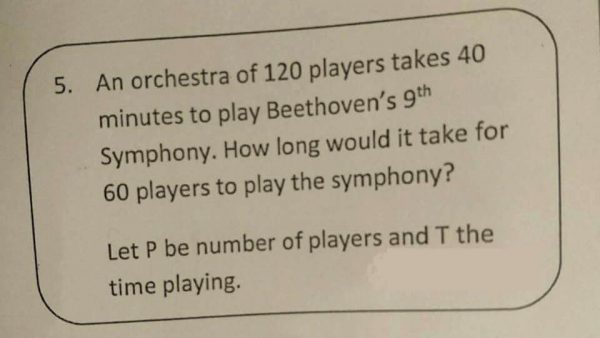You may by now have seen the image below knocking around on Twitter and other social medias, in which a maths question appears to be almost a parody of itself:

The text reads:
An orchestra of 120 players takes 40 minutes to play Beethoven’s 9th Symphony. How long would it take for 60 players to play the Symphony? Let P be the number of players and T the time playing.
Well, once you’re done laughing, we’ve done some investigative journalism and found the origin of this question. And it turns out it’s quite nice!
I wrote this!! How did you get this??? I am a maths teacher in Nottingham UK. Wrote this 10 years ago. Here is the original whole worksheet pic.twitter.com/jYX55GSBKz
— Claire Longmoor #FBPE (@LongmoorClaire) October 11, 2017
The question is from a worksheet developed by maths teacher Claire Longmoor (who is, based on current evidence, brilliant) ten years ago. Claire put together a selection of example questions with relationships in direct and inverse proportion, and deliberately included the orchestra question as an example of something where it doesn’t work that way. It’s a nice activity to help reinforce the difference, and in context the question works nicely.
Other examples on the sheet include a bricklaying example with creditably diverse gender representation, a car with terrifyingly low fuel efficiency, good cow names and a delightful insight into the bygone world of fruit picking.
You still can’t play Beethoven’s 9th in 40 minutes, though.
“It doesn’t say that they play it *nicely* in 40 mins” – Will Hornby on Twitter.
In fact they play all the right notes but not necessarily in the right order.
Well, it says an orchestra plays it. Without a choir and vocal soloists, they really couldn’t do the 4th movement. So I reckon they just played the first 3 movements, which is about 40 minutes!
Well, the conductor could always have a unique interpretation of tempo markings and conduct everything tutti.
Why do you say “by-gone world of fruit picking”?
Do you not think people still pick fruit? Does it just come out of a factory?
Takes the same time. The music notes and tempo don’t change regardless of the numbers of musicians.
Thanks last week!
Are all the picked fields the same area? Is the density of strawberries the same in all the fields? One field might have one in it. Do the pickers all pick at the same rate? Do they have breaks? Too many variables for direct proportion. E.g. bricks : all bricks the same size and weight; total weight of bricks is directly proportional to the number of them.